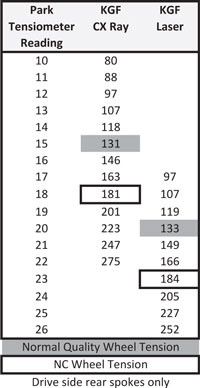|
Alloy Wheels Carbon Wheels Alloy Rims Spokes Alloy Wheel Building Bearing Adjustment Hub Assembly Hub Maintenance
Home
Your Shopping Cart

|
The skill of the wheelbuilder becomes more important as the number of spokes decreases. In the old days, 36 spoke wheels were overbuilt so spoke tension and overall build quality was more tolerant of a builders ability. Spoke tensiometers were non-existant and unnecessary.
A search of wholesale catalogs still shows typical bike shops only have access to 28,32, and 36 spoke hubs and rims (with few and expensive exceptions). Even if they can get a 24 hole DT or Chris King rear hub there is little or no rim selection. Therefore shops are not set up to deal with complete builds of low spoke count wheels.
The key element in building any wheel is making sure it’s as round as possible. That’s important because it’s going to affect the equalness of spoke tension more than any other element and getting tensions equal is important to increase wheel life. Our specification is 10/1000” for roundness. Often we can do better but because of rim tolerances it’s sometimes not possible. Most high quality wheel companies target .5 mm or roughly twice as much. To give you an idea of how round that is, it’s 1/4 turn of a spoke wrench.
 Contrary to popular belief, spoke tension doesn’t affect wheel stiffness, but the higher the spoke tension, the longer the wheel will stay true because spokes fail by fatigue and the higher the starting tension the longer they will stay tight (or more accurately the longer it will take before they become loose). Contrary to popular belief, spoke tension doesn’t affect wheel stiffness, but the higher the spoke tension, the longer the wheel will stay true because spokes fail by fatigue and the higher the starting tension the longer they will stay tight (or more accurately the longer it will take before they become loose).
Most high quality wheels build the drive side rear spokes (the tightest of all the spokes on the rim) to 130 KGF. The Park Spoke Tensiometer chart typically stops their chart at 160 KGF because rim spoke holes will start to fail at that tension. Because we use rim washers on those spokes - on alloy wheels, we build to 180-190 KGF without sacraficing rim integrity,
That’s an increase of about 40% in the key spoke tension. So the spoke washers add up to not only a stronger wheel but also a longer lasting wheel.
Carbon wheels require much less spoke tension because the rim is so stiff, the entire rim absorbs shock rather than a small section as happens on an alloy rim.
Finally, the experience of a wheel builder makes a big difference in the quality of the build. The more experienced the builder, the fewer times he or she has to turn the spoke wrench. With the newer low spoke count wheels it puts more stress on each spoke and also on each spoke hole in the rim. As the spokes are taken up to high tension the fewer times the builder turns a spoke nipple the stronger the rim because at high tension each time you turn the nipple you fatigue the spoke hole. I have seen many light rims under high spoke tension where you can actually see the alloy bulge at the spoke hole because either the spoke is too tight or the rim is fatigued. For that reason, amongst others, all of our wheels are completely trued under very low tension and tension is introduced with the fewest number of spoke turns. There is always a final amount of fine tuning done at the end but very little.
|

 Contrary to popular belief, spoke tension doesn’t affect wheel stiffness, but the higher the spoke tension, the longer the wheel will stay true because spokes fail by fatigue and the higher the starting tension the longer they will stay tight (or more accurately the longer it will take before they become loose).
Contrary to popular belief, spoke tension doesn’t affect wheel stiffness, but the higher the spoke tension, the longer the wheel will stay true because spokes fail by fatigue and the higher the starting tension the longer they will stay tight (or more accurately the longer it will take before they become loose).